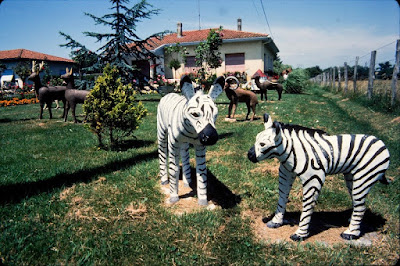 |
pictures (1990) courtesy of photographer © Francis David and the © Lille Art Museum |
Indeed, the sculpture garden as such doesn't exist anymore, but in 2018 reports have appeared which show that a large number of works have been preserved.
Life and works
Alphonso Calleja (1915 - ?) was born in Santiago du Chili, the capital of Chile, South America. In 1920 he moved with his family to France, where as an adult he worked in the paper mill Cellulose de Pin in Biganos, while he lived in the nearby community Gujan-Mestras.
These places are located along the Bassin d'Arcachon, a bay connected to the Atlantic Ocean, about 50 km south-west of Bordeaux. The bay is well-known because of its oyster culture and its surrounding area welcomes many holidaymakers.
In 1969, when Calleja was age 54, he started to decorate the garden with sculptures made of concrete, especially depicting animals, but also certain personalities, such as Charlie Chaplin.
The depicted animals are mainly of African origin, such as zebras, tigers, a panther, a rhinoceros, or a springbok. but Calleja also depicted some prehistoric animals.
The pictures show how the garden looked around 1990. These photos were taken by Francis David, a lover of art environments who between 1978 and 1992 traveled France several weeks a year to photograph these sites. Part of his large collection was published in March 2018 in the documentary website Habitants-Paysagistes edited by the Lille Art Museum.
During the years Calleja actively worked on the production of his bestiary, namely the last decades of the 20th century, the site received little publicity in what was then the literature of researchers of art environments. And when around 2008 writers about these sites became active on the internet, Calleja's sculpture garden already had ceased to exist.
In which year this happened, it was unclear for a long time, but it has recently become known that in 2008 the antiquarian Georges Schellinger, who is established in the region, bought Calleja's collection of sculptures. This sale undoubtedly took place because Calleja was deceased (in which year is not known) and the house probably was sold by the heir(s).
 |
| some smaller sculptures |
In 2010 antiquarian Schellinger sold the collection of sculptures to an inhabitant of Lège Cap-Ferret, another community located along the Bassin of Arcachon.
When in 2015 the new owner sold his house, Schellinger bought the collection back. It is now located on the densely wooded grounds around the branch office of the antiquarian on the avenue de la Vigne in Lège Cap-Ferret, where it can't be visited.
Documentation
* "Monsieur Calleja" in: Bulletin de l’Association Les Amis de François Ozenda, n°45, 1992.
* Series of pictures by Francis David on website Habitants-Paysagistes. Cartographie des jardins et maisons singuliers (edited by Lille Art Museum, France)
* Article in regional newspaper La Dépêche du Bassin, nr 1160, August 2018, p. 10 (This publication has been reported by Bruno Montpied in his weblog of December 11, 2018)
Alphonso Calleja
Bestiaire de ciment
(until 2008) 33470 Gujan-Mestras, dept Gironde, region Nouvelle-Aquitaine, France
(currently) avenue de la Vigne,
33970 Lège Cap-Ferret, dept Gironde, region Nouvelle-Aquitaine, France
no public visits
* Article in regional newspaper La Dépêche du Bassin, nr 1160, August 2018, p. 10 (This publication has been reported by Bruno Montpied in his weblog of December 11, 2018)
Alphonso Calleja
Bestiaire de ciment
(until 2008) 33470 Gujan-Mestras, dept Gironde, region Nouvelle-Aquitaine, France
(currently) avenue de la Vigne,
33970 Lège Cap-Ferret, dept Gironde, region Nouvelle-Aquitaine, France
no public visits



No comments:
Post a Comment